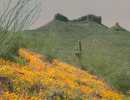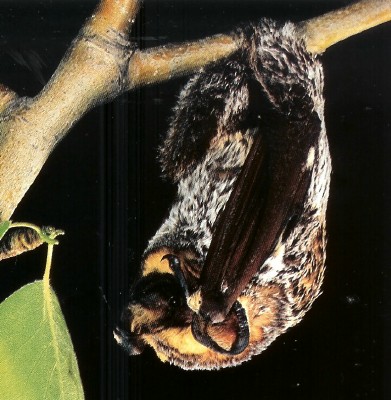
Cabeza Prieta Natural History Association
Sonoran Desert Mammals

Hoary bat
(Lasiurus cinereus)

|
Diet: moths, true bugs, mosquitos, other insects and occasionally other bats
Size: weight 25-30 grams (0.9-1.1 ounce) wingspan 34-41 centimeters (13-16 inches) Active Period: nocturnal |
This is the most widespread bat in the Americas.
Hoary bats are large, heavily furred bats. They spend summer days concealed in the foliage of trees, where they choose a leafy site well-covered above, but open from beneath, generally 3-5 meters (10-17 feet) above the ground and usually at the edge of a clearing. In late summer, they may wander into caves and many of these never find their way out. Because they spend the daylight hours well concealed, and generally are rare, they are seldom encountered by humans.
The sexes apparently are segregated throughout most of the summer range. They may fly during late afternoon on warm days in winter. Their swift and direct flight pattern and large size make them readily identifiable on the wing in most parts of the range.
Hoary bats bear two babies in mid-May, June, or early July. The young cling to the mother through the day, but are left clinging to a twig or leaf while she forages at night.
This article is from "Bats of the United States", 1999, by Michael J. Harvey of Tennessee Technological University, J. Scott Altenbach of the University of New Mexico, and Troy L. Best of Auburn University. Published by the Arkansas Game & Fish Commission, in cooperation with the Asheville Field Office of the U.S. Fish and Wildlife Service.
Photo Credit:
Photo #1
Copyright Creative Commons
HTML & Programing by
Thomas R. Powell